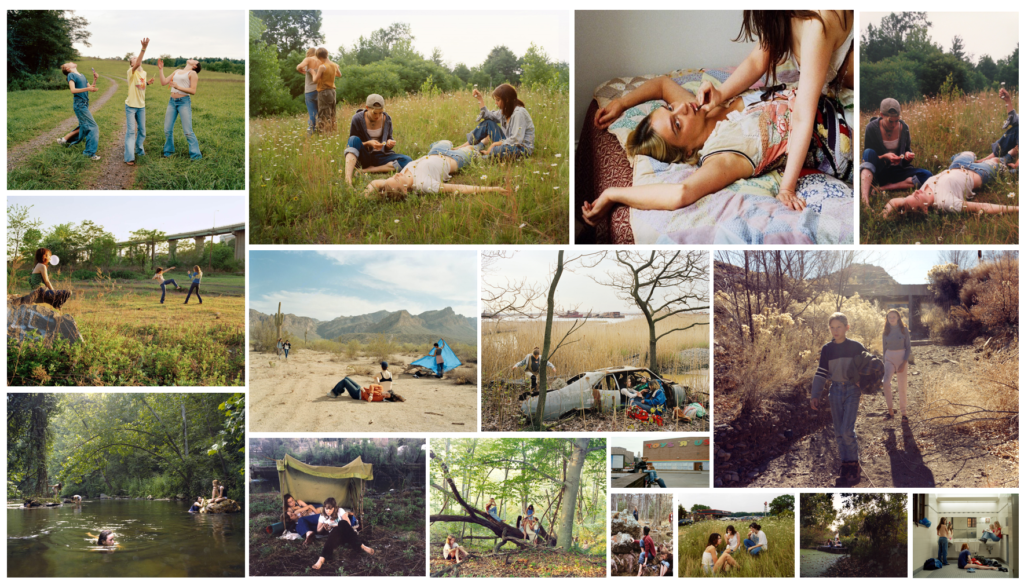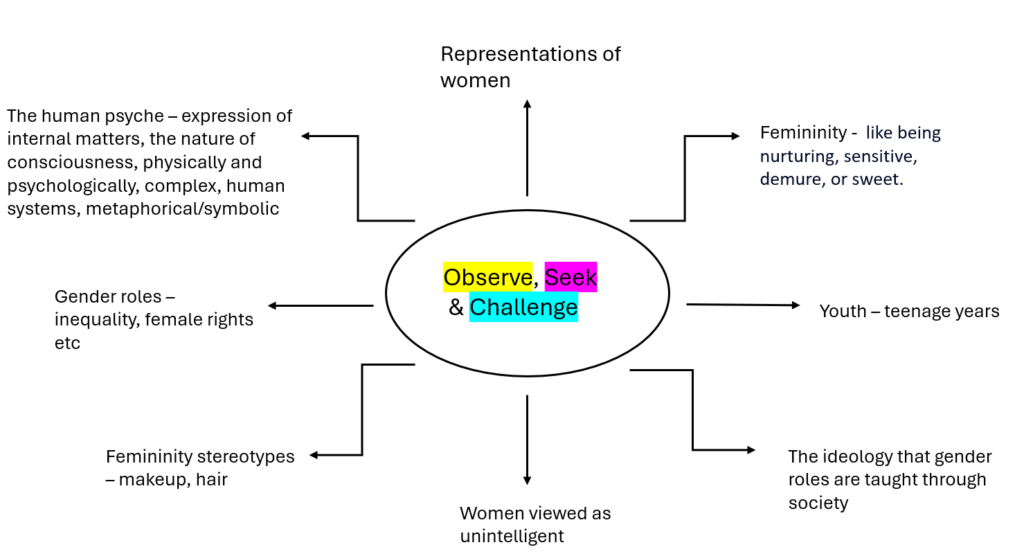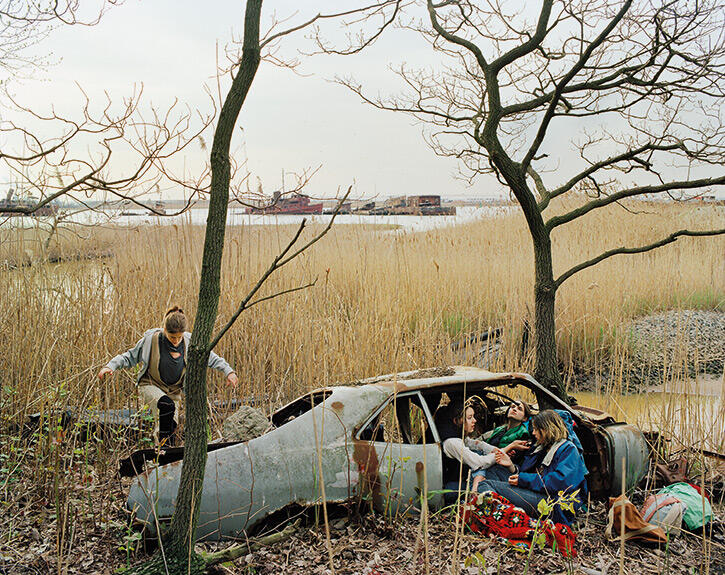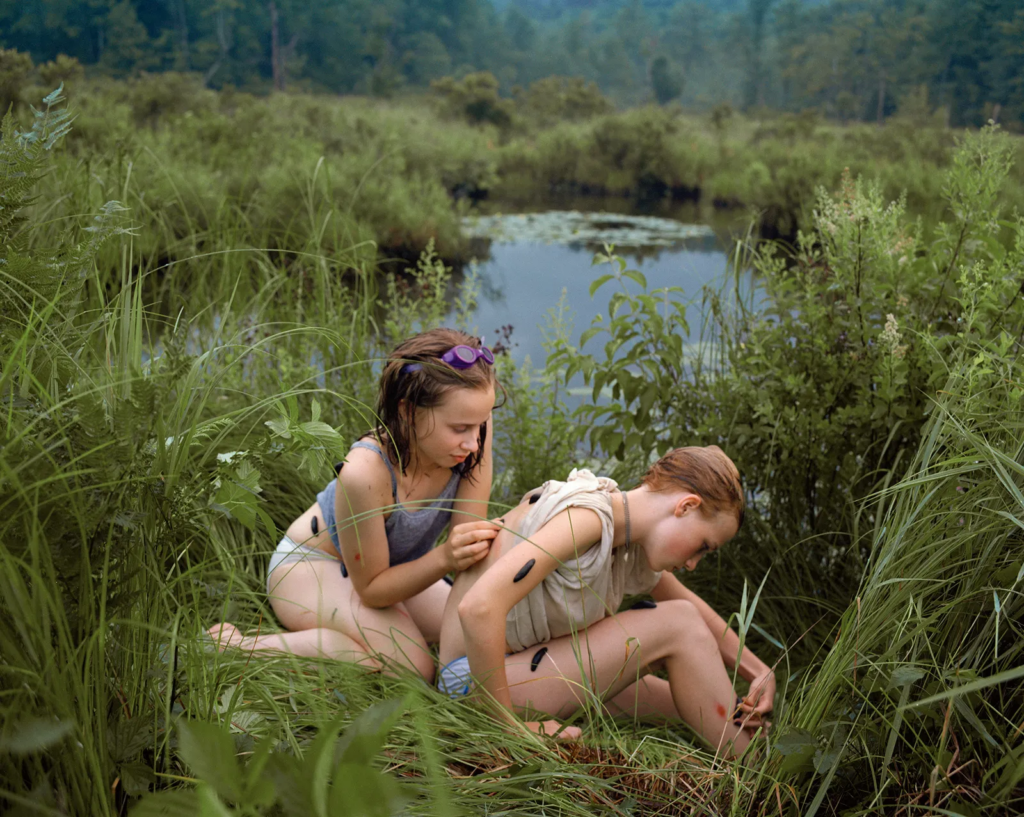Mood Board:

Mind map:

Who is Justine Kurland?
Justine Kurland is an American fine art photographer, born in 1969, based in New York City. Kurland holds a BFA from the School of Visual Arts and an MFA in photography from Yale University. She is best known for photographing subjects in American wilderness landscapes, and her strongly narrative work is influenced by 19th century English picturesque landscapes and the utopian ideal as well as genre paintings, the photographs of Julia Margaret Cameron and Mathew Brady, and illustrations from fairy tales. She has travelled across the United States to create these staged photos, including to Virginia and California, but spent many months traveling through New Zealand as well. Her photos of utopian-esque communities in Virginia and California earned her solo shows in London and Vienna. Kurland is very in touch with nature and the primal impulses of humanity. While creating her narrative of a teenage runaway, she was particularly interested in photographing within small, fringe areas of wilderness that remained between suburban and urban areas. She then talks to them about the scenes and scenarios she would like them to respond to and interpret for the camera.
Her photographs are also on view in NMWA’s exhibition Live Dangerously (September 19–January 20, 2020).

Justine Kurland, Shipwrecked, 2000.
What did Justine Kurland do?
Justine Kurland’s art is a vital part of the efflorescence of the staged photograph that began in the late 1990s. She creates her photographic series during extended road trips through the American Northwest or South. Using volunteer models she meets during her travels, Kurland constructs scenes of people rambling through the wilderness landscape.
“I photographed on extended road trips across the US, scouting locations and finding girls along the way. The girls would collaborate in staging the scenes. The girls performed scenes of caretaking that became actual caretaking: feeding each other, brushing each other’s hair, walking arm in arm. It was also a time when photographers were encouraged to stay in their lane. It was the 1990s, and it was considered exploitative for a white photographer to photograph a Black subject. I look at these pictures now, more than two decades later, and see that I both shaped and captured the racialized dreams of young white girls. ‘Girl Pictures’ (1997–2002) depicts a dream landscape, and a world at large, where even imaginations of resistance are misshapen by white supremacy”.
The 1980s was a time when many American women artists and photographers realized that they could be both the creator and the subject of their work, after battling many issues with gender roles and representations of women. I believe that Kurland created her photographic series to challenge these stereotypes by getting her models to perform behaviours that have constructed opposing ideologies to these stereotypes. But as things changed around Kurland herself, she identifies the election of Donald Trump as a moment where the meaning of her work shifted a bit. She stopped wanting to make that performance. She has since started new work she said is “all about looking inward and thinking about what I was running from.” She states that she no longer feels an uncomplicated identification with her old yearning for the West. But that shift helped her see something new in the photographs, which depict teenage girls in natural or nondescript settings, casting them in the adventurous roles of runaways and fighters.
Image analysis:

This image taken by Kurland caught my attention and stood out in comparison to the rest of her work. This is because it tackles a different approach to the Girl Pictures experimentation, as it contrasts to her other images by portraying less feminine qualities. For example, the two young girls in the image are dressed in minimal ragged clothing which straight away gives the impression that they have ran away from home and resorted to living outdoors. This challenges typical women stereotypes because usually women and young girls have been associated with having nurturing qualities and compassion, whereas these girls contrast this idea as they appear to be independent, brave and courageous by living in nature. Which girls are usually not associated with. Furthermore, the use of the goggles on the girls head show that she is confident and takes enjoyment from exploring the outdoors. This creates a sense of sympathy from the viewer, as we can infer from the image that the girls are young and perhaps they do not live the typical life of a young child – instead they have to cope on their own with no relatives to guide them through their childhood. Moreover, the background in the image has cooler tones running through it, which makes me assume that there is a type of mist or fog in the air implying that the weather is bitterly cold. This differs from the foreground of the image, as the colour of the long grass is slightly more vibrant. From this, I can gather that it is dusk, and the sky is about to darken. Both girls being sat down comfortably in overgrown grass demonstrate that they find comfort in nature, although the expressions of them show misery and weariness. The dark leeches contrast sharply to the pale skin of the two which exerts the challenge of the outside world. Despite the clear discomfort presented by the two in the image, there is also a sense of resilience in their posture and facial expressions, as they look focused and concentrated. It appears that the girls may be fascinated and somewhat amused by the creatures attaching to them. Overall, this scene has an effective blend of innocence and the unpredicted, as it perfectly highlights the uncomfortable beauty of the outdoors.
Image analysis 2:

The second image that I chose from Kurland’s series immediately caught my eye. It shows two young girls in a candid and natural setting, showing they are exploring the wilderness. As the girl on the left is seated and focusing on tying her boots, this tells me that they are getting ready for an adventure.

Girlhood
https://www.lensculture.com/ramona-wang
https://www.justinekurland.com/
https://www.wmagazine.com/culture/justine-kurland-girl-pictures-book-feature
https://www.vogue.com/article/the-bliss-of-girlhood-by-kristina-rozhkova
https://nmwa.org/whats-on/exhibitions/online/mary-ellen-mark-girlhood/
How women represent women in photography / art
https://femlens.com/blog-post/female-representation-in-photography-the-age-of-the-female-gaze/
https://medium.com/counterarts/women-in-art-and-photography-part-i-c677d64c8afa
https://artsandculture.google.com/usergallery/representation-of-women-in-art-through-the-ages/jwKisGWJM5SWKA
https://readframes.com/the-female-gaze-girlgaze-on-the-unique-vision-of-female-photographers-by-diana-nicholette-jeon/